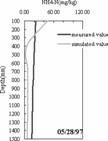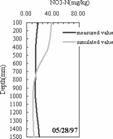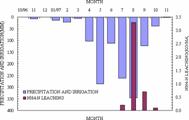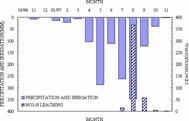Achievements
STUDY ON TRANSPORT AND TRANSFORM OF NITROGEN IN SOIL UNDER CONDITIONS OF FERTILIZER IRRIGATION IN TANGSHAN AGRICULTURE AREA
Department of Hydraulic and Hydropower Engineering,
Abstract: Nitrogen pollution problems in groundwater caused by fertilization are the focuses that people care very much in agriculture area now. Base on long-term observation and monitoring, nitrogen transfer and transform in soil is simulated by LEACHM model under irrigation and fertilization in
Key Words: Irrigation and fertilization; Ammonia-nitrogen; Nitrate-nitrogen; LEACHM model
1 Introduction
Nitrogen is the necessary nutrition substance for plant growing. It can make a better production, but unreasonable application of nitrogenous fertilizer leads to more negative impacts on surrounding environment, especially on aquatic environment. The nitrate concentration in surface water and groundwater has rise up to a critical degree of threatening human health[1]. Some foreign research shows that concentration in agriculture area is related with many factors such as ways of fertilization, application amount of fertilizer, soil character, irrigation water, precipitation and plant species. During fertilization period, amount of 12.5~40% fertilizer applied on soil surface leaches into groundwater through soil and then pollutes groundwater.
It has been the focus on groundwater polluted by nitrogen contamination that public pay attention to very much since 1960. Especially in the area of Beijing, Tianjin and Tangshan of North China where it regarded groundwater as main drinking water and source water, the pollution situations that groundwater is polluted by nitrate-nitrogen are very serious. Groundwater quality investigation has been done by HWCC (Haihe River Water Conservancy Commission) in
The article combines actual conditions of
2 Field Monitoring about Nitrogen Transfer and Transform in Soil
The nitrogen transfer and transform in soil includes a series of chemical and physical complicated processes under field conditions. In order to learn these clearly, a long-term monitoring and experiments were carried out in flat field in
3 Simulation of Nitrogen Transform and Transform in Field under Conditions of Irrigation and Fertilization
3.1Introduction of LEACHM model
LEACHM term is the shortened form of Leaching Estimation And Chemistry Model, which was studied and developed by
LEACHN model uses a finite-difference form of Richard's equation as a means of predicting water contents, fluxes and potentials. Richards' equation, the soil water flow equation for transient vertical flow derived from Darcy's law and the equation of continuity, is:

where  is volumetric water content (m3/m-3), H is hydraulic head (mm), K is hydraulic conductivity (mm/d), t is time (d), z is depth (mm), positive downwards and U is a sink term representing water lost per unit time by transpiration (d-1).
is volumetric water content (m3/m-3), H is hydraulic head (mm), K is hydraulic conductivity (mm/d), t is time (d), z is depth (mm), positive downwards and U is a sink term representing water lost per unit time by transpiration (d-1).
In model convection-diffusion equation is used to calculate contaminant concentration for nitrogen transfer. During calculation sink term and sorption by solid phase are considered, too. The equation is:

Where CL is solution concentration, and  indicates source and/or sink terms.
indicates source and/or sink terms.  is the apparent diffusion coefficient (mm2 d-1),
is the apparent diffusion coefficient (mm2 d-1), is soil bulk density (kg dm-3)
is soil bulk density (kg dm-3)
The main course of nitrogen degradation and transform include nitrogen mineralization, nitrification and denitrification of three organic nitrogen pools. The nitrogen amount absorbed by crop is regarded as function of root density, NH4-concentration and NO3-concentration. The model also considers more factors impacts on water transform and nitrogen movement in soil. In sum, LEACHM model can describe processes of water transfer and nitrogen transform varying with time and space distribution in soil. It can also reflect reaction on a great deal of physical, chemical and biological aspects and some other factors. So this model is adopted to carry on mathematics simulation under field conditions.
3.2 Model calibration
In order to prove reasonability and feasibility of LEACHN Model and use it to simulate and compute contamination concentration under precipitation, irrigation and fertilization
The data of water content, concentration of ammonia-nitrogen and concentration of nitrate-nitrogen monitored in soil at different times is the reliable evidence on model calibration. Six groups of measured data (surveying from October, 1996 to May, 1997) are used to model parameters calibration of water movement and nitrogen transform. Through making mathematical calculations and analyzing and adjusting repeatedly, satisfactory results were received. Fig. 1, Fig. 2 and Fig. 3 listed following show the results. Base on parameters calibration by using six data groups, other data groups are used to test model. From testing results that trend is similar as calibration result. According to results of model parameter calibration and model testing, it is rational and feasible for Leachn model to simulate and compute.






Fig1. Comparison between measured value and simulated value of water content






Fig2. Comparison between measured value and simulated value of NH4-N concentration






Fig3. Comparison between measured value and simulated value of NO3-N concentration
4 Simulation and Results Analysis
Many factors will impact transfer and transform of nitrogen in soil. When model is used to simulate under different scenarios, many factors like precipitation in different standard years, irrigation amount, fertilization amount, fertilizer type and application distribution in time and space are considered in the model. After it nitrogen leaching amount and quantitative analysis can be carried on under various kinds of conditions in soil profile.
4.1Conditions of variant precipitation and irrigation
According to the results of frequency analysis on time series of multi-annual precipitation data, frequency of 90% (drought year), 50%(general year) and 10%(wet year) are selected and use these precipitation data as input data to simulate and computation. The conditions of irrigation and fertilization keep invariant. Simulation time is 427 days. Simulation result is shown in table1.
From simulation result, some conclusions are gained listed as following:
Firstly the main leaching substance below root zone is in the form of nitrate-nitrogen, and amount of ammonia-nitrogen leaching into groundwater is very little. The reason is that soil adsorbs ammonia strongly when it passes soil profiles.
Secondly amount of leaching into groundwater rises up with irrigation and precipitatin rising. It is shown in table2.
Table1 leaching amount under different precipitation conditions
Frequency | P=90% | P=50% | P=10% | |
Precipitation(mm) | 423.8 | 613.1 | 837.0 | |
Irrigation(mm) | 450.0 | 450.0 | 450.0 | |
NH4-N (kg/ha) | leaching | 0.3 | 1.6 | 4.3 |
uptake | 6.3 | 9.2 | 22.7 | |
NO3-N (kg/ha) | leaching | 26.7 | 187.5 | 446.4 |
uptake | 263.5 | 257.6 | 239.9 | |
Table 2 leaching amount under different irrigation conditions
Precipitation(mm) | 610.4 | 610.4 | 610.4 | |
Irrigation(mm) | 450.0 | 225.0 | 0 | |
NH4-N (kg/ha) | leaching | 1.6 | 0.3 | 0.0 |
uptake | 9.2 | 6.0 | 5.1 | |
NO3-N (kg/ha) | leaching | 184.3 | 16.5 | 0.8 |
uptake | 257.7 | 262.1 | 266.6 | |
Thirdly, from fig4 it is founded that time for ammonia-nitrogen and nitrate-nitrogen leaching into groundwater is at July, August and September mainly. So leaching is related with irrigation and precipitation closely.


Fig4 distribution of nitrate and ammonia leaching in simulation time
4.2 Case of different fertilization
In order to show impacts on nitrogen leaching into groundwater caused by different fertilization, three different fertilization conditions are selected to simulate. There are
When amount of fertilizer increases the leaching amount also rises. In other hand, the initial concentration of soil profile also impact the result of leaching. These can be found in table3.
Table3 Simulation results under different fertilization conditions
Scenario | NH4-N(kg/ha) | NO3-N(kg/ha) | Total(kg/ha) | ||||
Leaching | Uptake | Leaching | Uptake | Leaching | Uptake | ||
①Normal | 1.6 | 9.2 | 184.3 | 257.7 | 185.9 | 266.9 | |
②5 times of Normal | 1.6 | 7.5 | 287.7 | 259.3 | 289.3 | 266.8 | |
③No chemical fertilizer | 1.6 | 12.9 | 158.4 | 253.2 | 160.0 | 266.1 | |
Ⅱ | ①Normal | 0.2 | 14.0 | 36.1 | 252.3 | 36.3 | 266.3 |
②5 times of Normal | 0.2 | 7.7 | 139.9 | 259.1 | 140.1 | 266.8 | |
③No chemical fertilizer | 0.2 | 42.5 | 10.2 | 193.6 | 10.4 | 236.1 | |
5 Conclusions
Some conclusions can be drawn briefly through simulation and analysis which is computed under different schemes:
1. Fertilizer and human manure are main sources which led to leaching of ammonia-nitrogen and nitrate-nitrogen in deep soil layers. They are also potential threaten of nitrogen pollution in shadow groundwater
2. Soil water is the necessary carrier for nitrogen leaching and leaching amount is affected deeply by precipitation and irrigation. Leaching amount in deep soil layers rises up with precipitation and irrigation rising up. Except scientific fertilizer application and improving use efficiency of nitrogen, it is very important to forecast rainfall and monitor water content correctly. Base on the premise that normal water that crops growing need is ensured. The scientific irrigation system should be made and control irrigating water and irrigating time effectively. Thus potential pollution into the shallow groundwater will reduce.
3. The nitrogen transfer and transform in soil includes a series of chemical and physical complicated processes under field conditions. It is difficult to simulate the chemical and physicalprocesses accurately. More study work should be continued.
References
[1] Vladimir Novotny Harvey Olem. Water Quality Prevention, Identification, and Management of Diffuse Pollution. Van Nostrand Reinhold, 1993.
[2] J.L.Huston R.J.Wagenet. Leaching Estimation and Chemistry Model. Research Series. Department of Soil, Crop and Atmospheric Sciences,




